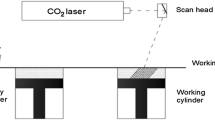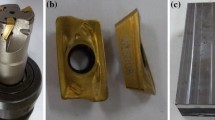Abstract
The present study highlights a multi-objective optimization problem by applying Weighted Principal Component Analysis (WPCA) coupled with Taguchi method through a case study in cylindrical grinding of UNS C34000 Medium Leaded Brass. The study aimed at evaluating the best process environment which could simultaneously satisfy multiple requirements of surface quality. In view of the fact that traditional Taguchi method fails to solve a multi-objective optimization problem, to overcome this limitation, WPCA has been coupled with Taguchi method. Furthermore, to follow the basic assumption of Taguchi method, i.e., quality attributes should be uncorrelated or independent; which is not always satisfied in practical situation; the study applied WPCA to eliminate response correlation and to evaluate independent or uncorrelated quality indices called principal components which were aggregated by WPCA to compute overall quality index denoted as Multi-Response Performance Index. A combined quality loss was then estimated which was optimized (minimized) finally. The study combined WPCA and Taguchi method for predicting optimal setting. Optimal result was verified through confirmatory test. This indicates application feasibility of the aforesaid methodology proposed for multi-response optimization and off-line control of correlated multiple surface quality characteristics in cylindrical grinding.
Similar content being viewed by others
References
Kwak JS (2005) Application of Taguchi and response surface methodologies for geometric error in surface grinding process. Int J of Mach Tools Manuf 45:327–334
Kwak JS, Sim SB, Jeong YD (2006) An analysis of grinding power and surface roughness in external cylindrical grinding of hardened SCM440 steel using the response surface method. Int J Mach Tools Manuf 46:304–312
Shaji S, Radhakrishnan V (2003) Analysis of process parameters in surface grinding with graphite as lubricant-based on the Taguchi method. J Mater Process Technol 141:51–59
Dhavlikar MN, Kulkarni MS, Mariappan V (2003) Combined Taguchi and dual response method for optimization of a centerless grinding operation. J Mater Process Technol 132:90–94
Hecker RL, Liang SY (2003) Predictive modelling of surface roughness in grinding. Int J Mach Tools Manuf 43:755–761
Zhong ZW, Peng ZF, Liu N (2007) Surface roughness characterization of thermally sprayed and precision machined WC-Co and alloy-625 coatings. Mater Charact 58:997–1005
Sun X, Stephenson DJ, Ohnishi O, Baldwin A (2006) An investigation into parallel and cross-grinding of BK7 glass. Precision Engg 30:145–153
Atzeni E, Iuliano L (2008) Experimental study on grinding of a sintered friction material. J Mater Process Technol 196:184–189
Choi TJ, Subrahmanya N, Li H, Shin YC (2008) Generalized practical models of cylindrical plunge grinding process. Int J Mach Tools Manuf 48:61–72
Liu CH, Chen A, Chen CCA, Wang YT (2005) Grinding force control in an automatic surface finishing system. J Mater Process Technol 170:367–373
Saglam H, Unsacar F, Yaldiz S (2005) An experimental investigation as to the effect of cutting parameters on roundness error and surface roughness in cylindrical grinding. Int J Prod Res 43(11):2309–2322
Sahoo P (2005) Engineering tribology. Prentice Hall of India, New Delhi
Datta S, Bandyopadhyay A, Pal PK (2008) Grey-based Taguchi method for optimization of bead geometry in submerged arc bead-on-plate welding. Int J Adv Manuf Technol 39:1136–1143
Datta S, Bandyopadhyay A, Pal PK (2006) Desirability function approach for solving multi-objective optimization problem in submerged arc welding. Int J Manuf Sci Prod 7(2):127–135
Kumar P, Barua PB, Gaindhar JL (2000) Quality optimization (multi-characteristics) through Taguchi’s technique and utility concept. Qual Reliab Engg Int 16:475–485
Walia RS, Shan HS, Kumar P (2006) Multi-response optimization of CFAAFM process through Taguchi method and utility concept. Mater Manuf Process 21:907–914
Mohanty SD, Datta, S, Mahapatra SS, Majumdar G (2009) Application of an integrated multi-objective optimization methodology in Flux Core Arc Welding (FCAW). Weld India 2009–10, National Welding Seminar NWS 2009–10, Organized by Indian Institute of Welding to be held on December 10–13, 2009 at Park Hotel, Kolkata
Hung-Chang L (2006) Multi-response optimization using weighted principal component. Int J Adv Manuf Technol 27:720–725
Datta S, Nandi G, Bandyopadhyay A, Pal PK (2009) Application of PCA-based hybrid Taguchi method for multi-criteria optimization of submerged arc weld: a case study. Int J Adv Manuf Technol 45(3–4):276–286
Antony J, Antony F (2001) Teaching the Taguchi method to industrial engineers. Work Study 50(4):141–149
Ful-Chiang Wu (2005) Optimization of correlated multiple quality characteristics using desirability function. Qual Eng 17(1):119–126
Huang MS, Lin T-Y (2008) Simulation of a regression-model and PCA-based searching method developed for setting the robust injection molding parameters of multi-quality characteristics. Int J Heat and Mass Transf. doi:10.1016/j.ijheatmasstransfer.2008.05.016
Oberg E, Jones FD, Horton HL, Ryffel HH (2000) Machinery’s hand book. Industrial, New York
Peace GS (1993) Taguchi methods—a hands-on approach. Addison-Wesley, Massachusetts
Author information
Authors and Affiliations
Corresponding author
Rights and permissions
About this article
Cite this article
Routara, B.C., Mohanty, S.D., Datta, S. et al. Combined quality loss (CQL) concept in WPCA-based Taguchi philosophy for optimization of multiple surface quality characteristics of UNS C34000 brass in cylindrical grinding. Int J Adv Manuf Technol 51, 135–143 (2010). https://doi.org/10.1007/s00170-010-2599-1
Received:
Accepted:
Published:
Issue Date:
DOI: https://doi.org/10.1007/s00170-010-2599-1




